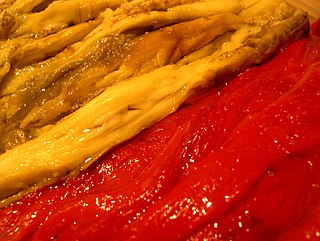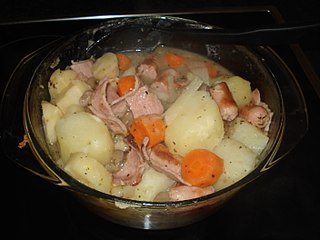Related Research Articles

Scotch broth is a soup originating in Scotland. The principal ingredients are usually barley, stewing or braising cuts of lamb, mutton or beef, root vegetables, and dried pulses. Cabbage and leeks are often added shortly before serving to preserve their texture, colour and flavours. The proportions and ingredients vary according to the recipe or availability. Scotch broth has been sold ready-prepared in tins for many years.

Trifle is a layered dessert of English origin. The usual ingredients are a thin layer of sponge fingers or sponge cake soaked in sherry or another fortified wine, a fruit element, custard and whipped cream layered in that order in a glass dish. The contents of a trifle are highly variable and many varieties exist, some forgoing fruit entirely and instead using other ingredients, such as chocolate, coffee or vanilla. The fruit and sponge layers may be suspended in fruit-flavoured jelly, and these ingredients are usually arranged to produce three or four layers. The assembled dessert can be topped with whipped cream or, more traditionally, syllabub.

Tzatziki, also known as cacık or tarator, is a class of dip, soup, or sauce found in the cuisines of Southeastern Europe and the Middle East. It is made of salted strained yogurt or diluted yogurt mixed with cucumbers, garlic, salt, olive oil, sometimes with vinegar or lemon juice, and herbs such as dill, mint, parsley and thyme. It is served as a cold appetizer (mezze), a side dish, and as a sauce for souvlaki and gyros sandwiches and other foods.

Escalivada, also sometimes transcribed in French as 'escalibade' and in Spanish as escalibada, is a traditional dish from Catalonia, Valencia, Murcia and Aragón of smoky grilled vegetables. It typically consists of roasted eggplant and bell peppers with olive oil and sometimes onion, tomato, minced garlic, and salt.

A pasty is a British baked pastry, a traditional variety of which is particularly associated with Cornwall, South West England, but has spread all over the British Isles. It is made by placing an uncooked filling, typically meat and vegetables, in the middle of a flat shortcrust pastry circle, bringing the edges together in the middle, and crimping over the top to form a seal before baking.

Shepherd's pie, cottage pie, or in its French version hachis Parmentier is a savoury dish of cooked minced meat topped with mashed potato and baked. The meat used may be either previously cooked or freshly minced. The usual meats are beef or lamb. The two English terms have been used interchangeably since they came into use in the late 18th and the 19th century, although some writers insist that a shepherd's pie should contain lamb or mutton, and a cottage pie, beef.

A mirepoix is a mixture of diced vegetables cooked with fat for a long time on low heat without coloring or browning. The ingredients are not sautéed or otherwise hard-cooked, because the intention is to sweeten rather than caramelize them. Mirepoix is a long-standing part of French cuisine and is the flavor base for a wide variety of dishes, including stocks, soups, stews, and sauces.

Coddle is an Irish dish which is often made to use up leftovers. It most commonly consists of layers of roughly sliced pork sausages and rashers with chunky potatoes, sliced onion, salt, pepper, and herbs. Traditionally, it can also include barley.

Deviled eggs, also known as devilled eggs, Itlog ni Lee, stuffed eggs, Russian eggs, curried eggs or dressed eggs, are hard-boiled eggs that have been shelled, cut in half, and filled with a paste made from the egg yolks mixed with other ingredients such as mayonnaise and mustard. They are generally served cold as a side dish, appetizer or a main course during gatherings or parties. The dish's origin can be seen in recipes for boiled, seasoned eggs as far back as ancient Rome, where they were traditionally served as a first course. The dish is popular in Europe, North America and Australia.

Jane Grigson was an English cookery writer. In the latter part of the 20th century she was the author of the food column for The Observer and wrote numerous books about European cuisines and traditional British dishes. Her work proved influential in promoting British food.

Pease pudding, also known as pease porridge, is a savoury pudding dish made of boiled legumes, typically split yellow peas, with water, salt and spices, and often cooked with a bacon or ham joint. A common dish in the north-east of England, it is consumed to a lesser extent in the rest of Britain, as well as in other regions worldwide.

Glamorgan sausage is a traditional Welsh vegetarian sausage for which the main ingredients are cheese, leeks and breadcrumbs. It is named after the historic county of Glamorgan in Wales.

Steak and kidney pudding is a traditional British main course in which beef steak and beef, veal, pork or lamb kidney are enclosed in suet pastry and slow-steamed on a stovetop.

Lincolnshire sausages are a distinctive variety of pork sausage developed in and associated with the English county of Lincolnshire.

Sussex pond pudding, or well pudding, is a traditional English pudding from the southern county of Sussex. It is made of a suet pastry, filled with butter and sugar, and is boiled or steamed for several hours. Modern versions of the recipe often include a whole lemon enclosed in the pastry. The dish is first recorded in Hannah Woolley's 1672 book The Queen-Like Closet.

Tunisian cuisine, the cuisine of Tunisia, consists of the cooking traditions, ingredients, recipes and techniques developed in Tunisia since antiquity. It is mainly a blend of Mediterranean and native Punics-Berber cuisine. Historically, Tunisian cuisine influenced many cultures and nations like Italians, Andalusians, French and Arabs.

Kısır is a bulgur based salad found in Turkish cuisine, similar to the Armenian eetch and Lebanese tabouleh. The main ingredients are finely ground bulgur, parsley, and tomato paste. Common additional ingredients include onion, garlic, sour pomegranate molasses, olive oil and lemon juice, cucumber, cornichons and spices. It can be served with lettuce leaves. It has a reddish color due to tomato paste admixture. It is served at room temperature as either a side-dish or meze appetizer.

Stuffed tomatoes are one of a number of dishes in which tomatoes are filled with ingredients, usually including rice.

A Book of Mediterranean Food was an influential cookery book written by Elizabeth David in 1950, her first, and published by John Lehmann. After years of rationing and wartime austerity, the book brought light and colour back to English cooking, with simple fresh ingredients, from David's experience of Mediterranean cooking while living in France, Italy and Greece. The book was illustrated by John Minton, and the chapters were introduced with quotations from famous writers.

Pigs in blankets or kilted soldiers is a dish served in the United Kingdom and Ireland consisting of small sausages wrapped in bacon. They are a popular and traditional accompaniment to roast turkey in a Christmas dinner and are served as a side dish.
References
- ↑ "Local Butcher's account of the historical significance of stuffed chine" . Retrieved 30 December 2011.
- ↑ "Lincolnshire Stuffed Chine" . Grantham Journal. 29 December 1894. Retrieved 15 February 2015– via British Newspaper Archive.
- ↑ Grigson, Jane (3 November 2005). "Observer classic". The Guardian. London. Archived from the original on 13 March 2016. Retrieved 7 March 2012.
- ↑ "Great British Kitchen" . Retrieved 30 December 2011.
- ↑ "Crocus Colouring" . Sunderland Daily Echo and Shipping Gazette. 18 May 1936. Retrieved 15 February 2015– via British Newspaper Archive.